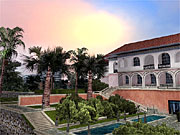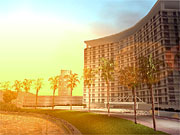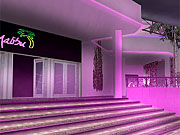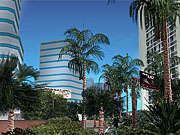Grand Theft Auto: Vice City Graphics Q&A
We sit down with Rockstar North to find out about Vice City's graphics and technical aspects.
See it in Action!
While last year saw the release of a number of high-profile console games like Halo and Metal Gear Solid 2: Sons of Liberty, it was Rockstar's Grand Theft Auto III that ultimately stole the show. The game blended the open-ended structure of typical PC games with extremely polished driving and action gameplay in a setting replete with crime and treachery. Whether you actively played through the game's story-driven campaign or simply ran amok throughout Liberty City, Grand Theft Auto III was an addictive and enjoyable experience through and through. Earlier this year, Rockstar announced that it would be following up on GTAIII with a sequel that takes place in the 1980s, Vice City. The overall visual theme in this sequel will be one that attempts to capture the essence of Miami Vice and Scarface, but its gameplay will be pure Grand Theft Auto. To find out more about the technical aspects and inspiration behind the graphics of the forthcoming Vice City, we sat down with Adam Fowler, one of Rockstar North's technical directors, and Aaron Garbut, the company's art director.
GameSpot: What can you tell us about Vice City's graphics engine?

Adam Fowler: Vice City's graphics engine is based loosely on the Grand Theft Auto III engine, with many improvements added. One of the obvious improvements is the addition of skins for the pedestrians. This allows our artists to produce much more realistic and graphically pleasing peds. One of the less obvious improvements is our use of occlusion volumes. This allows us to stop drawing objects that are hidden behind buildings, and scene complexity can therefore be increased because we are only drawing the objects the player can see.
GS: Grand Theft Auto III used a stylish sort of blur effect throughout the game. Will that same effect be in Vice City?
Aaron Garbut: The effect is there, but altered. The blur this time tends to echo the effect of strong sunshine bleaching out light colors.
GS: What kind of graphical or performance differences will we see between Grand Theft Auto III and Vice City?
AG: Generally, the level of detail in the game has at least doubled. We're using twice as many polys and textures on almost every object. The cars have loads more detail, and the peds are skinned, creating a far smoother look. We had a good look at how we built Liberty City and found what was fast and what was slow within the engine. Obbe [Vermeij], one of the technical directors, wrote a real-time occlusion system, which works out whether buildings are blocking the view and whether it needs to draw all the objects behind it. This has given us a lot of breathing space to squeeze in that extra detail. We've also got a lot of new effects: heat haze from the roads, flamethrowers, explosions, lots of aquatic life in the ocean, birds, flies, and a much better day-night cycle with lots of neon casting light everywhere. Generally speaking, as with the rest of the game, it's a case of bigger, better, faster, more.

AF: Vice City will be able to display more peds and more vehicles. Both pedestrians and vehicles have higher polygon counts. Pedestrians are now skinned, as mentioned. Because the level size has doubled in Vice City, the game has to display far more buildings at any one time. We've been able to include these increases because of improvements in the rendering engine and also improvements in our model culling methods. Vice City has many more visual effects, including sun reflection on water and raindrops on the screen.
GS: Did the fact that the game is a PlayStation 2 exclusive allow for more freedom?
AG: Not having to consider a second platform in development is always easier. Concentrating on the PS2 gives us a consistent platform across the entire team. That way, when one person finds a certain part of the game slow, we can be sure everyone else will and do something about it. In some respects this makes things easier, but...well, you can't make up excuses anymore.
Going Back in Time
GS: How did the game's setting affect its art style and look?
AG: The 1980s are a constant throughout every aspect of the game--from the front-end and loading screens to the advertising on billboards in the game, the props that appear in the interiors, the furniture, and the clothes the people wear. It does make things a bit trickier. Setting things in the past ended up giving us a lot more work, as some of our props were not invented. It also meant redesigning every single car from Grand Theft Auto III, since none of them were around at that time, either. What it has done, though, is given us a lot of scope for humor and a sense of consistency that would otherwise be tricky to achieve.
GS: Where did you look for inspiration for the game's overall look?

AG: As with Grand Theft Auto III, we watched a lot of films and pored over every book we could find. The whole team also went to Miami and did a lot of research themselves. We got a lot of inspiration from Scarface, Carlito's Way, and, of course, Miami Vice. We wanted to make Vice City seem bright and colorful. I personally hate the kind of hyperreal photographic look that succeeds in making a game look either brown or gray. If I wanted to spend time in a gray city, I'd go back to our old offices in Dundee and stand in the rain.
GS: How did you go about conveying location through the graphics?
AG: Basing the city on such a strongly visual city as Miami made things pretty easy. It's such a distinct city, and it's great fun to model, with all the curves and overhangs on the art deco buildings. Obviously, the lighting, weather, and water had to change from the rainy, dull, and morbid Liberty City. We concentrated on making things bright, colorful, and pastel-shaded. The water changed a lot, with environment mapping to make it seem reflective and add sparkles glinting from the sun on the surface. It's also transparent now, as we wanted it to seem clean and clear (although it did mean modeling the entire seabed too.)
GS: What are you proudest of about the Grand Theft Auto: Vice City engine?
AG: As with Grand Theft Auto III, the draw distance. There are very few games with this much detail and action taking place onscreen and this number of characters and vehicles around. I don't think there are any games that do that and still draw 2.5km into the distance at all times.
AF: Probably the best thing about the Vice City engine is the same as with Grand Theft Auto III--the streaming technology. We spent a lot of time on this when developing Grand Theft Auto III, and without it, the game would not have worked. Again, with Vice City, we spent a lot of time improving the streaming. In Vice City it doesn't just stream textures and models, it also streams collision and animation. The animation streaming means we can have special one-off animations like the skaters, joggers, sunbathers, and so on.
GS: How many different pedestrian skins and models are in the game?

AG: There will be 110 different ambient pedestrian models on the street and around 50 story characters. Each character has a higher poly count and twice the number of textures than the characters in Grand Theft Auto III, and they're fully skinned to be nice and smooth with no segmented joins.
GS: What sort of new weapon and explosion effects can we expect to see?
AG: There are heat haze effects on some of the weapons such as the flamethrower. The explosion effect has been revamped, with the main force of the explosion emitting from the fuel tank, which gives quite a spectacular result. Every other effect has been enhanced and tweaked in some way--nothing remains the same as Grand Theft Auto III.
GS: Sounds great, guys. Thanks for your time.
Got a news tip or want to contact us directly? Email news@gamespot.com
Join the conversation